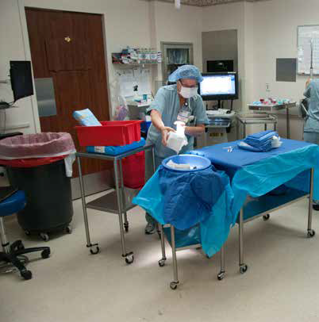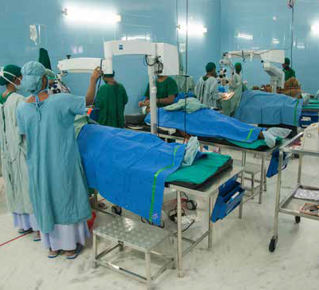Sustainability
Links in Eye Care Delivery and Climate Change
Exploring the relationship shows strategies are needed for both mitigation and adaptation.

Cheryl Guttman Krader
Published: Tuesday, August 29, 2023
“ If global healthcare were a country, it would be the fifth largest contributor to carbon emissions in the world. “
As large contributors to greenhouse gas emissions, healthcare systems have a major impact on climate change, which already negatively impacts healthcare delivery. Breaking the cycle requires ophthalmologists and associated stakeholders to implement strategies for reducing their carbon footprint and adapting to climate change, emphasised Dr Cassandra Thiel.
“If global healthcare were a country, it would be the fifth largest contributor to carbon emissions in the world,” she said. “We need to mitigate our greenhouse gas emissions to reduce the negative impact the care we provide has on the population, health, and the environment. But we also have to think about preparing for the consequences of climate change-related events that interfere with our ability to deliver care. By rethinking how things are done, we have an opportunity to impact climate change and improve care. And adaptations in our health systems will enable recovery from climate shocks and perhaps leave them operating better than before.”
Improving sustainability
 Focusing on the carbon footprint of cataract surgery (one of the most commonly performed operations), Dr Thiel reviewed findings from studies examining emissions related to surgical supply manufacturing, distribution, and waste. These findings show substantial differences in waste generated through cataract surgery conducted in high-income versus low-income countries, indicating opportunities exist for increasing resource efficiency without compromising outcome quality.
Focusing on the carbon footprint of cataract surgery (one of the most commonly performed operations), Dr Thiel reviewed findings from studies examining emissions related to surgical supply manufacturing, distribution, and waste. These findings show substantial differences in waste generated through cataract surgery conducted in high-income versus low-income countries, indicating opportunities exist for increasing resource efficiency without compromising outcome quality.
For example, analyses performed using environmental life cycle assessment showed a phacoemulsification procedure at Aravind Eye Centre in India emits about 5% of the greenhouse gases of one in the United Kingdom.1,2
“Cataract surgery is much more efficient at Aravind than in developed countries, and Aravind’s outcomes are just as good,” Dr Thiel said. “Therefore, we know cataract surgery can be done differently yet safely.”
 Similarly, results from a study analysing data obtained with “Eyefficiency,” a cataract surgical services auditing tool Dr Thiel and colleagues developed to help units improve their surgical productivity and reduce costs, waste generation, and carbon footprint, showed significant variations in measured endpoints between centres located in different geographic regions.3
Similarly, results from a study analysing data obtained with “Eyefficiency,” a cataract surgical services auditing tool Dr Thiel and colleagues developed to help units improve their surgical productivity and reduce costs, waste generation, and carbon footprint, showed significant variations in measured endpoints between centres located in different geographic regions.3
“Often, we found that lower-income countries lacking the resources to spend a lot on supplies already implemented very efficient ways to perform cataract surgery and do it well,” she said. “These are [lessons] practices can use to improve value by reducing costs and minimising their environmental footprint while still providing high-quality care.”
To assist US surgeons in making changes prioritising sustainability, Dr Thiel and colleagues created decision flowcharts for selecting interventions related to supplies and pharmaceuticals used in cataract surgery.4
“‘Do we need to use it?’ is the first question you should ask about every supply and pharmaceutical you have in your procedure room,” she said.
“If the answer is no, then consider if you can remove it from your custom packs. If a supply is needed, ask if it has to be single use, and for necessary drugs, consider if any part is being wasted after surgery.”
Dr Thiel also discussed EyeSustain as a resource for information on reducing surgical waste and ophthalmology’s carbon footprint (eyesustain.org). As part of its mission to make ophthalmic care and surgery more sustainable, EyeSustain’s leadership reaches out to manufacturers and regulators to achieve changes.
Steps for climate change resiliency
Strategies for adapting to and coping with the potential for hazardous impacts of climatic events are harder to specify, Dr Thiel said, because they can be unique to individual institutions, depending on such issues as existing infrastructure and the likely threats. The process for becoming more climate change resilient begins with assembling a diverse team of relevant stakeholders who will then work to characterise valued and crucial assets, the risks to those assets from a possible climatic event (e.g., wildfires, hurricanes, floods), the likelihood of any such event, and the resulting consequences.
Energy sourcing has been one such focus of adaptation strategies. Solar panel installation is a step facilities have taken to ensure power is available if a climatic event shuts down the grid, but it has additional benefits. For facilities where grid operation is not always reliable, having a constant power supply might lengthen equipment lifespan. In addition, solar panels represent an environmentally friendly, clean energy source.
While strategies for reducing and reusing supplies are part of the framework for climate change mitigation, they are also relevant for adaptation because they lessen the impact of a non-functioning supply chain.
“Overall, the main theme is rethinking how we are doing things by asking, ‘Do they have to be done that way?’,” she concluded.
Dr Thiel spoke at ARVO 2023 in New Orleans, Louisiana, US.
For citation notes, see page 54.
Cassandra Thiel PhD is an Assistant Professor, Departments of Population Health and Ophthalmology, New York University and NYU Langone Health, New York, US. Cassandra.Thiel@nyulangone.org
Latest Articles
Towards a Unified IOL Classification
The new IOL functional classification needs a strong and unified effort from surgeons, societies, and industry.
The 5 Ws of Post-Presbyopic IOL Enhancement
Fine-tuning refractive outcomes to meet patient expectations.
AI Shows Promise for Meibography Grading
Study demonstrates accuracy in detecting abnormalities and subtle changes in meibomian glands.
Are There Differences Between Male and Female Eyes?
TOGA Session panel underlined the need for more studies on gender differences.
Simulating Laser Vision Correction Outcomes
Individualised planning models could reduce ectasia risk and improve outcomes.
Need to Know: Aberrations, Aberrometry, and Aberropia
Understanding the nomenclature and techniques.
When Is It Time to Remove a Phakic IOL?
Close monitoring of endothelial cell loss in phakic IOL patients and timely explantation may avoid surgical complications.
Delivering Uncompromising Cataract Care
Expert panel considers tips and tricks for cataracts and compromised corneas.
Organising for Success
Professional and personal goals drive practice ownership and operational choices.